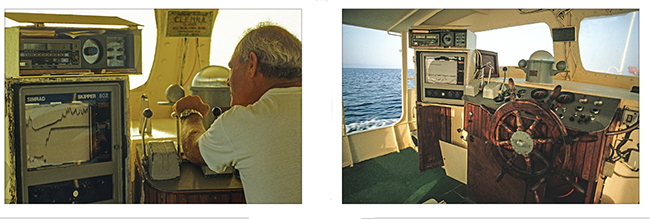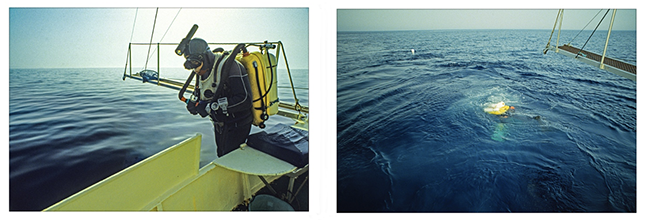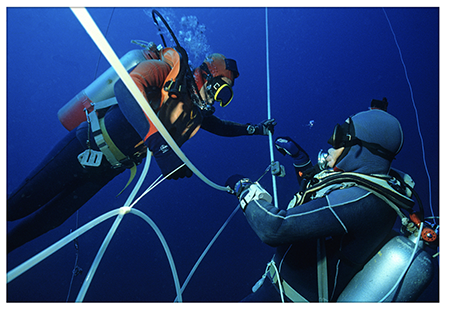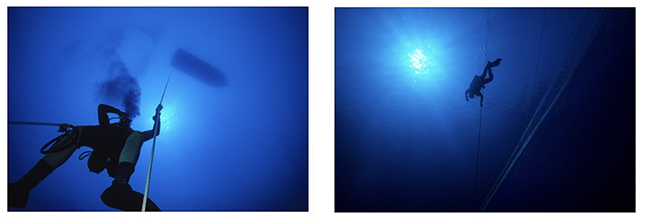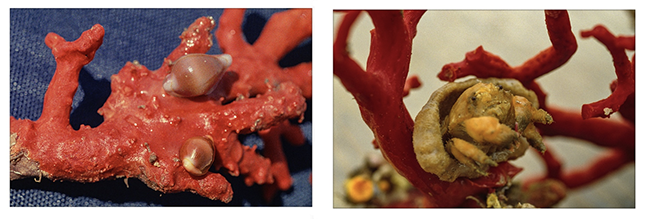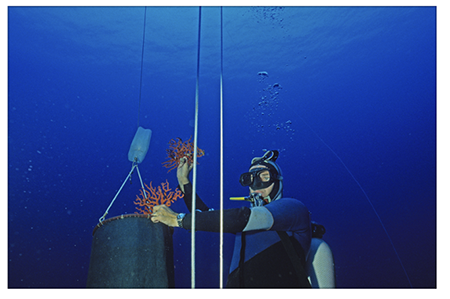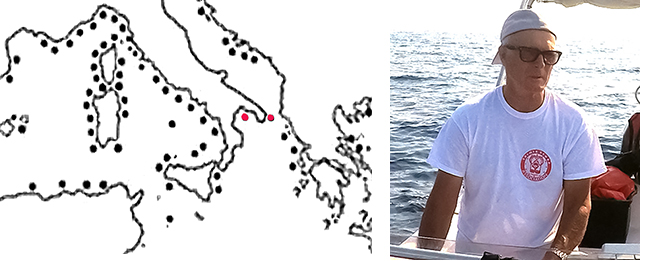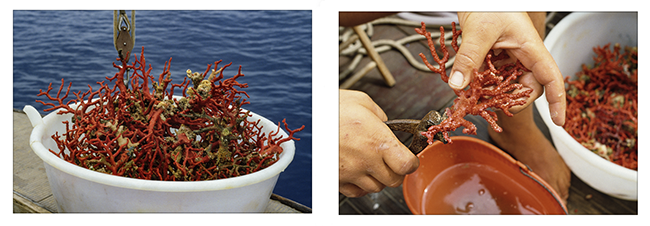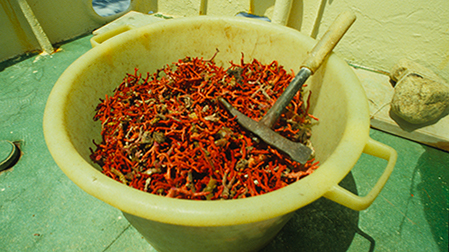SEPTEMBER 1994
I return to Sardinia after having spent the month of August going around the Maddalena archipelago, as I have been doing for years. My friend Angelo Gadau, important dive photographer introduced me some of the most known Sardinian coral hunters, and now I am in Porto Conte (Alghero) where all began in 1955, when Leonardo Fusco, Claudio Ripa, Ennio Falco and "Pelos" La Capria arrived. At Giglio Point of Caccia Cape they found coral at a depth of 20 meters; it was small and thin; they could not even pay their costs, so they decided to leave. But, on their last day, they entered a cave with the entrance at 30 meters; this cave had the walls entirely covered of gorgeous Mediterranean Corallium rubrum dressed in the whitest cnidarians; they stopped and, as Gaetano Cafiero tells in his famous book "Vita da Sub" (Diver’s life), in few days they collected 200 kilograms of coral.
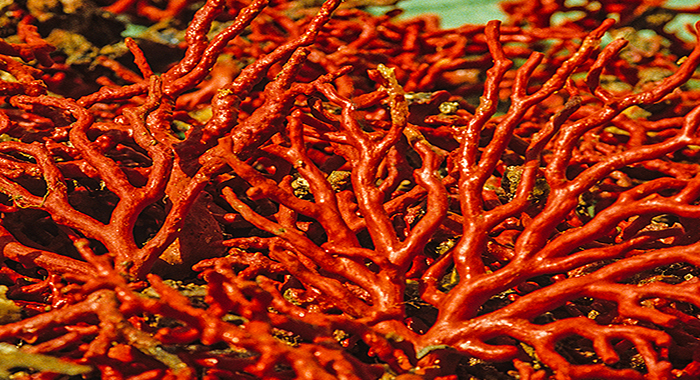
(All photos in this article are by the author)
This area has always been known for red coral; it was attended by boats called “Coralline” equipped with the “Ingegno”; however, this hellish tool could not enter caves, which remained intact during the centuries.
At Porto Conte I dive once with two shy divers; they were diving beyond 70 meters with air with oxygen decompression; they did not seem to be too organized, and they collected the leftovers of previous divers. What interest me was the beautiful mini submarine that others were finishing to build, hoping to obtain the permission to go deeper and sure to search for the precious branches. This authorization never came, and the unit will be used for less romantic dive works. Too bad, the idea of going for a ride was in my head.
I conform myself with delicious dinners in an Italian trattoria just outside town, where I happened to know about a nice story, not concerning diving. A talk about wild boars comes up, the current proliferation was not yet suspected, and they were considered absolutely wild animals, difficult to spot and dangerous. In fact, a tv crew based there sometime before was engaged in a reportage about these wild fanged to film them in the arduous ravines and bushes in the surrounding mountains. A very difficult and hard job, or so it had to appear on tv. The locals laugh, I don’t understand why; then, the owner takes me to the back yard of the restaurant, that is all shrubs and undergrowth; I see a net and a gate; he whistles, and from the scrub, 4 or 5 boars appear in the large corral. And it was through that net that they were immortalized from the cameras of the heroic tv crew!!
In the next days, I go back and forth several times to Stintino and, above all, to Santa Teresa of Gallura; I wake up at 4 to meet with Angelo before dawn at the outskirts of Sassari. At Santa Teresa port we drink a coffee before we go on board; the seaman already organized everything, and we let the moorings go. Antonio Murru and Mario Bulciolu set up their gear; when we are past the Bocche of Bonifacio, Murru takes the helm and sets the coordinates in the Gps of one of the hundred secret points marked in the paper lying on the dashboard. He says something to the trusted seaman and reaches us at steam. This iron boat painted in sand color is quite big; we can move comfortably among the intimidating packs of helium and oxygen cylinders, the large compressor, the tens of equipment around. The two hyperbaric chambers are on a side, camouflaged behind the wheelhouse.
|
Fig. 2-3 - Antonio Murru at the controls of his large, well-equipped boat |
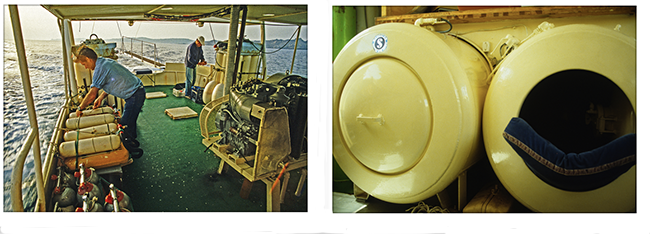 |
4-5 - Murru and Bulciolo finish to prepare their gear. The large boat hosts in its stern the compressor, the group
of helium and oxygen bottles. In the picture on the right, the two recompression chambers on board.
It is the second time I dive with them; today, these two gentlemen will dive at turn in the same place. They begin to dress together; when we will see the buoy in the surface launched by Bulciolu, after few minutes his partner will descend. I also wear my suit; my breathing apparatus with one 15-liter bottle with two regulators is ready, together with my Nikonos camera with 15 mm lens; in my left wrist I wear my Aladin Pro computer, in the right wrist my spare Suunto computer. Our agreements are clear; once in the water, I will be alone. The seaman will not watch me because his single distraction may menace the two divers’ safety. They dive with their modified semi-closed circuit Dräger FGG III rebreathers, with two bottles of 10 liter each added in the back. Since few minutes, Murru is fixing my Aladin computer, he asks me if it is trustworthy, he would like to try it. I tell him that its maximum depth is 99 meters, beyond that depth it will crash. He takes me to show the trace of the echo sounder; they will descend in two near rocks with a bottom around 93 meters. I hand him over my Aladin computer; he fixes it near his watch and depth gauge. His partner jumps into the water; they planned a bottom time of 15 minutes. Decompression will develop according to the description I made in the previous article, with their ascent on the boat to rapidly get into the hyperbaric chamber to spend decompression long final part. Time passes very quickly; I watch the breaking in the surface of the random bubbles issued by the rebreather; today the sea is very calm, and it is easy to follow them but, how do they do with choppy sea? Here is Bulciolu’s buoy; calmly, Murru finishes to gear up, check his watch and, after twenty minutes from his partner’s jump, he descends.
|
6-7 - Antonio Murru with rebreather ready to jump; Rolex watch, Gsd depth gauge and my Aladin Pro computer on his wrist. At the right, water entry near the buoy launched by his partner before beginning to ascent. |
I remain on board to assist to the decompression procedures and see the non-stop work of the seaman that, firstly dropped the double-tank unit containing air for the decompression of the first diver; then, the rope with the ballast for the diver, the rope to recover his rebreather with a hanging board for eventual communications, at last the hot water hose. At the end, he drops to 15 meters the pipe with the oxygen regulator, ready for the last part of the in-water decompression. Bulciolu is probably ending his decompression with air; his partner shortly will begin his ascent from the bottom, and I want to meet him while he ascends. At 60 meters in the crystal-clear water, I stops on his bubbles; higher, I clearly see our boat profile. For a moment, I enjoy a feeling
of total freedom; I am in the void hanging motionless and light on my buoyancy compensator, no one around, only a silent bubble passes by me from time to time. From the dark underneath me, Murru quickly appears, surpasses me, and stops just before 50 meters together with a strong whining, a continuous alarm lament from my poor Aladin. Later he will tell me that the rock, on one side, descended at 106 meters therefore, my computer went all above his limits. My computer will continue to complain for the next 36 hours. From the boat, the air double tank unit arrives; he calmly switches it; rebreather and coppo leave for the surface. The diver with my screaming computer begins the first phase of his decompression, while Bulciolu almost ended it and begins to ascend to the oxygen stop. They meet for some instants, and they exchange a greet.
|
8 - Meeting between buddies in decompression |
|
9-10 - The deeper deco stop is over, but the boat is still a long way off |
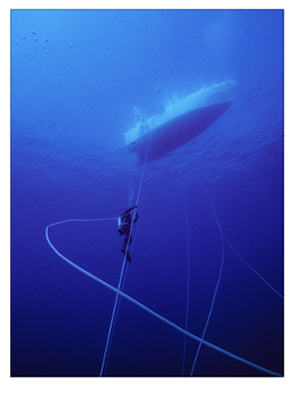
11 - The diver approaches the depth where the oxygen regulator awaits him
By watching above the surface, it all seems a manifest chaos of crossing ropes and hoses, dropping or ascending things but everything runs as planned, in order and in perfect synchrony. When Murru arrives at the oxygen stop I ascend, I end my decompression and, once on the boat, I see one of the two chambers closed. He ascends; when on board he rapidly undresses, and he asks me which is the problem of my Aladin computer that is so loud. Then, naked, he enters the second chamber from where he will exit when we are already in the port since some time; it is almost evening, the right time for aperitive.
|
12-13 - Parasitic coral snails. On the right a small crab, another host of the coral |
In the next days I am in Stintino; I go out with Massimo Ciliberto. He and his partner dive with open circuit; their tri-bottle units arrive already filled with mix gases; their boat is not too big and decompression chamber takes half of the space at stern.
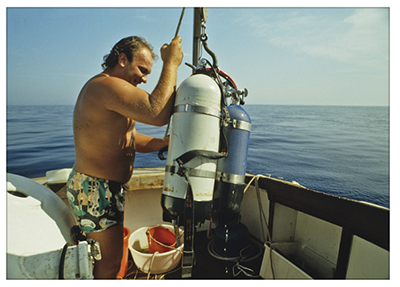 |
They also dive one after the other; the first leaves the signal only if he finds a rock that deserves it. It is not today’s case; the coppo ascends with almost nothing and decision must be taken if returning to a known place where they can collect at least what is needed to cover todays’ expenses or try the luck. In the squared paper it is highlighted a point very far from the others; a small and lonely rock surrounded by mud, discovered long time before by the echo sounder. If nothing is there, the day will end in a very negative way. Decision is taken; we go there. The buoy is launched in the exact point; Ciliberto wears his bulky gear and jumps, following the direct rope to the rock. After a while, I follow him; in the surface, thousands of bubbles reach the surface, frying while breaking and, from the dark, their white wake appear, interrupted to indicate me where to stop and wait for him. Then his shape appears framed by the bubbles; he has his big coppo almost full; he stops with smiling eyes to show me a couple of branches. Fortune goddess said yes.
14 – In the above picture, the seaman assistant raises the 18+18+10 tri-bottle unit with mix gases.
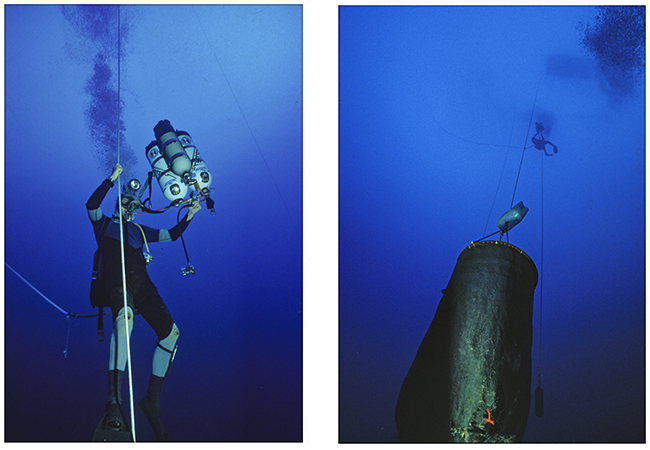 |
15-16 – The tri-bottle unit with mix gases was changed with the air unit which is now going to be sent on the surface.
In the other picture, the “coppo” device hanging in the rope dropped by the boat will soon be raised, while on top
you can see the diver engaged in changing his breathing apparatus to begin decompression.
|
17 – The diver shows two coral branches that almost |
|
18-19 - Return to Santa Teresa di Gallura. On the right one of the many |
SEPTEMBER 2021
I did not know anything about red coral in Puglia, the lowest region in the south-eastern part of continental Italy. I thought it was not there, although in an ancient map of the Ingegno times two valid points were indicated. Nicoletta and Pier Da Rolt spoke to me about a coral hunter leaving there; they told me "he is a very good friend, he will be able to tell you a lot of stories”. A couple of phone calls and I drive to Otranto, accompanied by the northwest wind which makes a very dark blue sea and a bright air, as only these coasts can offer.
I meet Salvatore Bortone and his wife Rita Chiurli; they own the DWD Diving Salento center based at Marina di Castro. Their welcome is worthy of the best traditions of southern Italy.
For seven years he worked as a freelance professional diver, in 1978 for Sub Sea Oil Service, afterwards for Micoperi for saturation jobs in offshore oil platforms in the world. "Then" – he says - "I did not resist to the recall of my homeland, I returned, got married and now I have a beautiful family".
|
20-21 – The old map dating back to the “Ingegno” device time shows that in Puglia there |
I asked him about coral. He tells me that in Puglia it was unknown, no one was interested. The first divers to collect it were people from Naples in the 60s. They travelled around almost all coasts of Puglia, from Otranto to Taranto. These two divers’ name where maybe Pane and Perez; the third one conducted the wooden fishing boat and was very skilled in interpreting the echo sounder signals. In Otranto, there is a very known shoal called Mine because, underneath, there is a big mine of the last war. It has a depth between 45 and 51 meters, it is small approx. 25 x 6 meters, and at that time it was so filled with coral that you could not even see the rock. They collected several hundred kilograms; after that, the descended south and a seaman of Tricase told them about a fabulous place; a wall about one mile long and deep between 60 to 68 meters where they made about seven hundred kilograms of coral. They descended with air mix, with stones for ballast inside the coppo, leaving them in the bottom
Local seamen naively and continuously gave them rock and wall points; they were promising echo sounders at an unreachable price at the time, boding to make them reach. From Tricase they arrived at Santa Maria of Leuca, then to the Ugento shoals of coral origin to discover in the middle of the sand, about eight miles offshore. They are very bright; they form big atolls raised on one meter and a half from the bottom. Now they are completely occupied by Gerardia savaglia grown in very large shrubs never seen elsewhere of the diameter of 80 cm, branched off in trunks of 30-35 cm. Then, these Naples guys arrived at Gallipoli, where they collected tons of coral going through the walls quickly hunting for the best branches, without completely emptying the area.
"I began to hunt coral at the beginning of the 80s" - Bortone says - "together with a local guy. We went out with Professor Zizzi, a big expert and owner of a nice two-engine boat; we divided the expenses by four (one for the boat). It lasted some years. Later, I went out with my rubber boat from Marina of Castro. Rarely we collected more than 25-30 kilograms of coral every year, nothing special, often at a depth around 50 meters. At that time, coral was sold around 700.000 lire for 1 kilogram; one million of lire if there was a particularly large branch. In the Ugento sea, there were some walls luckily unknown to the three Naples guys, very difficult to spot and reach because of the surface currents that, in summertime, may reach 5,5 - 6 nots making diving very difficult; these currents suddenly end around 17 meters. We were helping ourselves with the aid of the first small diving scooters, internally reinforced to sustain higher pressures above 40 meters, depth limit for which they were built. We were diving with air gas with one 15+15 bottle unit with separated tanks; for decompression we were using Ean 40 mix on a side bottle. We have dived with Comex tables and other tables for the Ean mix. We never used pure oxygen not to go too high with partial pressure. We had the tables for the emergency in-water therapeutic recompression, to be done only if the diver is well, alert and has no cold. We used them several times when we exited with symptoms, and they always functioned well. My experience lasted a decade however, I do not feel myself as a real coral hunter because I did not dive every day; I did it for passion, for that special feeling when you see those red branches and you dream, you keep on thinking what can I find tomorrow".
Later we go to Gallipoli from their friend Giuseppe De Donno, professional coral hunter for almost 40 years. He confirms that no one knew about coral until the three Naples guys arrived in the 60s; however, the ballast of a Saint Andrew’s cross, that is the Ingegno was found, demonstrating that, in this area, the coral boats arrived a long time ago.Coral boom in Gallipoli is around 77s-78s. "At the beginning I had dived only with air gas" - De Donno remembers - "the average depth was around 70 meters, sometimes at 90; I often reached 100 meters diving with mix gases. The rocky walls were usually empty, one branch here, one branch there; we had to dive a long way. Then, it happened to reach a small rock completely covered with thick branches, usually between 60 and 70 meters. In 2016, I found three rocks full of coral around 60 meters; this season produced 50 kilograms; another time, I went to 2 rocks at 55 meters, and in four dives we collected 20 kilograms. Before and after these rocks, there was nothing. I believe it depends above all on the type of rocks, not only on currents. I fished in Leuca, but there were too many variable currents; then, from Gallipoli towards Ugento, a narrow area full of rocks to explore one by one, and of deep walls up to a depth of 65 meters".
|
22-23 – In the bucket, the coral picked-up during one dive, on the right, coral branch cleaning |
The research, he says, happened with the echo sounder but without Gps, so we had to find these points taken references on the ground. Each point was identified with a number referred to the notes written in a diary, exactly marked on a squared sheet which meant one square mile. Near Saint Andrew Island (Gallipoli) in 1994, people dived in small rocks scattered in the mud between 58 and 62 meters; they found them full of coral; this area produced 80 kilograms in two; during 1994, they made their record with 160 kilograms.
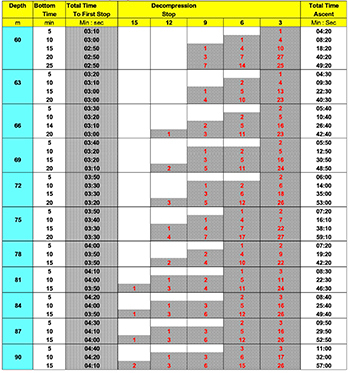 |
In 1990, coral was paid around 600.000 lire for one kilogram. Normally, two divers could produce 40-50 kilograms per year, that is a yearly income of around 25 million of lire. After 2000, coral was worth 1 million/1.300.000 lire; however, 40.000 euro became much less than the previous 25 million. Unfortunately, in these last years, its price lowered sensitively. Now, some divers go to grasp even the thin branches; in this way, all is destroyed, and coral of old times will not appear anymore. Also, if it seems that in these areas coral growth is fast, in less than 20 years it produces long but thin branches, 4-5 mm. at the base; in fact, coral was picked up in some zones were the three famous Naples guys were surely passed. To prove it, there were both the ballast stones put in the coppo, discharged in the bottom, and the rope pieces used for their buoys, now incorporated in the regrown branches.
Fig. 24 - U.S. Navy air table 1973
De Donno and his partner exit with a 15-meter fishing boat called "Nautilus II"; their gear was a three-bottle breathing unit, at the beginning with 12+12+12 liters bottles, then with 15+15+15 with air gas; for decompression, they used the U.S. Navy tables. If they had to go below 80 meters they filled bottles with mixed gas, usually with 40% of helium.
Today, in this area, there is some coral fisherman who operates regularly, others randomly. All have the permit. In Puglia you can dive coral all year around, but it is not worth during wintertime; water is murky and cold; then, you must consider making 5 or 6 dives to find a valid point. It is not as before.When it is almost time to say goodbye, De Donno draws a notebook on which he reported everything, day by day, with the exact points visited and the coral taken. He collected a pile of these notebooks, one for each year in which he operated. These pages contain all dive coordinates, plus a treasure of information, of memories and secrets that each coral hunter jealously guard.
|
Fig 25 - The picket in the coral bucket |
_______________________
